Broken Bay Water Police: Some History
Pittwater Online keeps receiving emails and interest in this history page from 2013 - so, for those who missed it the first time round, we run it for you this week.
Policing and protecting those on our waters began fairly soon after Europeans began settling in Sydney. With more and more people deciding to try a new life in a brand new world, as well as a continued transportation of convicts, thefts and crimes on our harbour at 'Port Jackson' required a solution.
Some sources point to the beginnings of the NSW Water Police as taking place on the 7th August, 1789 when Governor Phillip established a civilian ‘police force’ of twelve watchmen, enlisted from well behaved convicts to patrol on shore at night. The duty roll of these watchmen was enlarged, and eventually took over patrols in the government boats formerly performed by Royal Navy Marines with duties of preventing the escape of prisoners and smuggling.
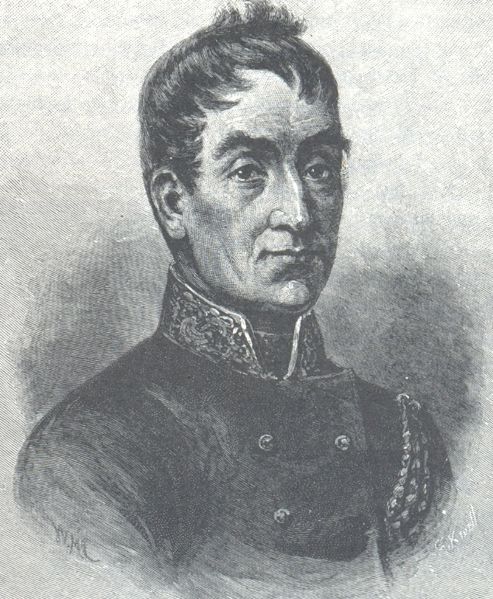 In 1817, John Cadman, an ex-convict, aged 41, was officially appointed by Governor Macquarie, 'the Father of Australia' as his coxswain. With this appointment came the title of Superintendent of Government Boats. The Harbour Patrol, as the watchmen had become known, then came under Cadman and became known as the Rowboat Guard.
In 1817, John Cadman, an ex-convict, aged 41, was officially appointed by Governor Macquarie, 'the Father of Australia' as his coxswain. With this appointment came the title of Superintendent of Government Boats. The Harbour Patrol, as the watchmen had become known, then came under Cadman and became known as the Rowboat Guard.
Right: Governor Macquarie- Illustration from Volume I of "The Picturesque Atlas of Australasia" by Andrew Garran, 1888
John Cadman, Coxswain of the Antelope, from 25th Dec. 1817, to 24th Dec. 1819. – £30.00. GOVERNMENT AND GENERAL ORDERS. (1820, March 18).The Sydney Gazette and New South Wales Advertiser (NSW : 1803 - 1842), p. 2. Retrieved from http://nla.gov.au/nla.news-article217932
In the Sydney Gazette of 1.8.1818, p. 3, the Antelope is described as ‘a boat of 20 tons, belonging to the Government dock-yard.’
GOVERNMENT AND GENERAL ORDERS.
GOVERNMENT HOUSE, SYDNEY-,
5th February, 1820.
CIVIL DEPARTMENT.
THE frequent Depredations committed afloat, and piratical Seizures of Boats and small Craft in Sydney Cove, and other Places within the Harbour of Port Jackson, together with the Injury done to the Revenue by the Smuggling of Spirits and other Goods from Ships and Vessels in the Harbour, rendering it of the greatest Importance that a System of Police should be established for the Prevention of the said Offences; His EXCELLENCY the GOVERNOR is pleased hereby to notify, that from the present Date, one or more Row Guard Boats will be established, consisting of two Masters and two Boatswains with such Number of Sailors as the Duty may require.—-And His EXCELLENCY is pleased to order and direct,
1st. That one Master and one Boatswain, assisted by three Sailors, be employed during each Day in rowing about through the various Ships or Vessels in the Harbour, in Order to prevent or detect Smuggling, and to keep Boats of every Description from holding Correspondence with Convicts before being landed from the Ships in which they arrive, or having other Intercourse with such Vessel, unless when they shall be employed in furnishing Stores or Pro-visions from the Commissariat to said Ships, or be authorised specially to convey Persons back and forward between them and the Shore ; which special Authority must be duly obtained by His EXCELLENCY'S Permission, nothing herein being meant to prevent the Intercourse of Ships' Boats in pro-per Hours with the Shore, as directed in the Port Regulations.
2nd. During the Night, that a similar Party do keep a most vigilant Watch to prevent Smuggling, or Boats with Convicts on board going along-side of Ships or Vessels. In the Event of any Persons being detected acting in Breach of the Port Regulations in any of these or other Particulars, it will be the Duty of the Row Guard to apprehend and confine them for the Night in a Watch-house, and until such Time as they shall be further dealt with according to Law.
3rd. One of the Masters of the Row Guard, with his Boat and Crew complete, is to accompany all Ships or Vessels, departing from Port Jackson, to the Outside of the Heads, and is not on any Account to permit Boats from the Shore to go along-side of said Vessels, when under Sail ; or to suffer any Persons from such Boats to go on board of such Ships or Ves-sels, unless Persons belonging to the said Vessels, whose Names appear in their Port Clearance ;—-And it is ordered and directed, that the Masters of the said Row Boats shall receive and duly execute such Orders as shall be given to them by the Naval Officer, in Regard to searching and smoking Vessels previous to their Sailing ; and they are also to render Account, and be duly amenable to the said Na-val Officer in all Things touching the Revenue, & the Smuggling and Seizure of Goods, Boats, or other Articles there with connected.
4th. That Edward Ewing and Daniel Cubitt be appointed Masters of the said Row Boats, and Thomas Beddows and David Anderson, Boatswains, with such Salaries and Allowances as shall be specified in their respective Contracts with the Chief Engineer ;and that they make a written Report to him at the Hour of Ten each Morning, stating therein the Circumstances attending the Execution of their respective Duties for the preceding Day ; or, in his Absence, that they make said Report to the Principal Superintendent of Convicts.
5th. That from and after the 20th Instant, all Boats and small Craft, plying within the Harbour of Port Jackson, do have their Names, and those of their Masters, written in legible Characters on their Bowsor Sterns, as may be most convenient, and duly num-bered from the Office of the Naval Officer, which Number is also to be marked on the said Boats in like Manner as their Names, &c.
6th. That all Boats, plying in Port Jackson, be made fast with an Iron Chain from Sun-set to Sunrise, on Pain of Seizure, and the Owner or Owners being fined.
7. In Order to encourage to the more effectual Performance of the Duties herein directed, it is further ordered and directed, that One-third Part of all Seizures (when duly condemned) which shall be made by the said Row Boat or Boats, and their Crews, shall be divided in the following Manner between the Master, Boatswain, and Crew of the Boat which shall make the Seizure, in the following Proportions ;—-
viz.
Half of that One-third to the Master, and the other Half of said Third to be divided equally between the Boatswain and Crew of said Boat; the remaining Two-thirds of all Seizures, when duly condemned, to go in Aid of the General Police Fund.
And it is further ordered and directed, that nothing herein contained shall be construed to interfere with the Rules and Regulations already established by the Port Regulations.
By His Excellency's Command,
J. T. CAMPBELL, Secretary.
GOVERNMENT AND GENERAL ORDERS. (1820, February 12).The Sydney Gazette and New South Wales Advertiser (NSW : 1803 - 1842), p. 1. Retrieved from http://nla.gov.au/nla.news-article2179262
In 1833 the Rowboat Guard were first officially described as the Water Police. The title 'Water Police' became official through the Government Gazette No. XVII of the 6th October, 1840. With this new official Police Unit the personnel was increased to 40 Water Policemen. Some Extracts from this Act;
No; XVII: An Act for the further and better Regulation and Government of Seamen within the Colony of New South Wales and its Dependencies and for establishing a Water Police. [6th October, 1840.]
WHEREAS great delay and inconvenience have been occasioned to the owners and masters of vessels trading to and arriving at Port Jackson and other ports or harbours in the Colony of New South Wales by the desertion and other improper conduct of seamen belonging to such vessels and whereas the laws heretofore passed in the said Colony for the regulation and management of seamen therein are insufficient for the purposes intended and it is necessary to make further provision for the regulation and good government of seamen and to establish a Water Police for the better and more efficiently enforcing the law and whereas it is just and proper that the expenses of forming and maintaining such police force should be borne by the owners of such vessels Be it therefore enacted by His Excellency the Governor of New South Wales with the advice of the Legislative Council thereof
That from and after the passing of this Act it shall be lawful for the Governor for the time being of the said Colony from time to time by warrant under his hand to appoint one or more fit and proper person or persons as a Justice or Justices of the Peace to execute the duties of Superintendent or Superintendents of Water Police and such other duties as are hereinafter specified within the Harbour of Port Jackson and within such other ports or harbours within the said Colony or its Dependencies as the provisions of this Act shall as hereinafter mentioned be extended to by the Governor of the said Colony and such person or persons so to he appointed shall in addition to the powers and authorities vested in him or them by this Act have the like powers and authorities and be enabled to execute all the duties created and imposed by a certain Act of the said Governor and Council passed in the fourth year of the reign of His late Majesty King William the Fourth intituled " An Act for regulating the Police in the Town and Port of Sydney and for removing and preventing Nuisances " and “Obstructions therein" and the said Governor shall and may from time to time remove and displace such Superintendent or Superintendents of Water Police and appoint another or others in his or their place or stead as the said Governor may think fit.
2. And be it enacted That every person appointed a Superintendent of Water Police as aforesaid shall before he shall begin to execute the duties of his office take the following oath before one of the Judges of the Supreme Court of the said Colony (or before the Judge or Chief Magistrate of the port or harbour for which he shall be appointed to act) that is to say—
"I A. B. do swear that I will faithfully impartially and honestly to the best of my skill and knowledge execute all the powers and duties of a Justice of the Peace and Superintendent of Water Police imposed by and under an Act of the Governor and Legislative Council of the said Colony passed in the fourth year of the reign of Her Majesty Queen Victoria intituled " An Act for the further and " better regulation and government of Seamen within the " Colony of New South Wales and its Dependencies and "for establishing a Water Police "
And in addition thereto the Justice or Justices of the Peace appointed under this Act Superintendent or Superintendents of Water Police for the Port of Sydney shall before he or they shall begin to execute the duties of his or their office take the following oath before one of the Judges of the Supreme Court of the said Colony (that is to say)—
" I A. B. do swear that I will faithfully impartially and honestly according to the best of my skill and knowledge execute all the powers and duties of a Justice of the Peace imposed by and under an Act of the Governor and Legislative Council of the said Colony passed in the fourth year of the reign of His late Majesty King William the Fourth intituled 'An Act for regulating the Police in the Town and Port of Sydney and for removing and preventing Nuisances and Obstructions therein.' "
Captain Hutchinson Hothersall Browne was appointed Water Police Magistrate for Sydney when the office was established in 1840, becoming Registrar of the Court of Requests at the end of 1843 and then re-appointed to his previous position of Water Police Magistrate in 1847. It is this gentleman who visited Broken Bay in June 1842 on the revenue cutter Ariel to seize smuggled spirits. Smuggling At Broken Bay by Shelagh Champion relates this part of our history.
One of these revenue cutters was the Prince George, a wooden vessel of 51 tons, built at Hastings, Great Britain in 1832 for the Port of Sydney.
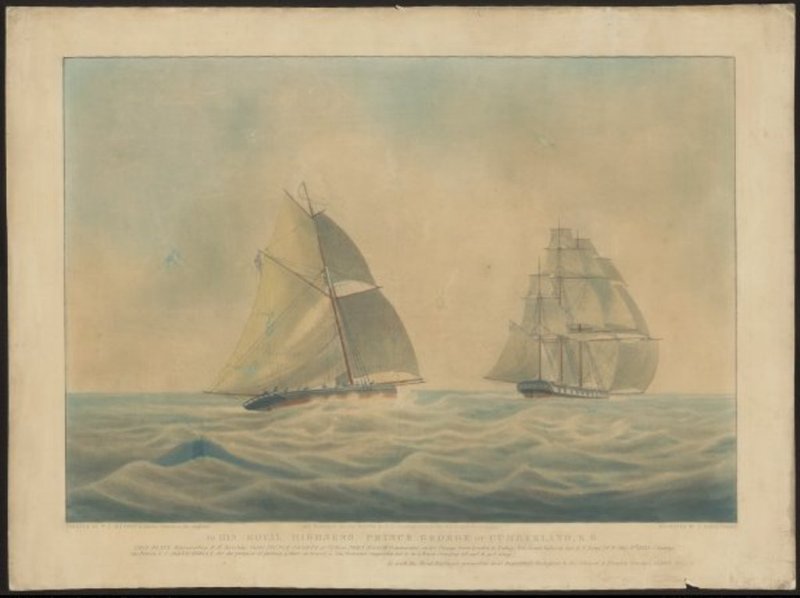
H.M. revenue cutter Prince George on her voyage from London to Sydney chasing the French E.I. ship Victorine for the purpose of putting letters on board painted by W.J. Huggins; engraved by C. Rosenberg. Image anl9576718 courtesy National Library of Australia
The Cricket Player reports the revenue cutter, Prince George, lying at Pittwater: the Rover left the same time as the Cricket Player for Sydney. SHIPPING INTELLIGENCE. (1842, September 3). The Sydney Morning Herald (NSW : 1842 - 1954), p. 2. Retrieved from http://nla.gov.au/nla.news-article12414886
The Water Police of then, like the Rowboat Guard, were entitled to a portion of seized goods, and as this cache was rather large, he did rather well. There is evidence that a Water Police detachment had been sent to Broken Bay soon after and would have been appointed to police the area as part of the duties of the Broken Bay Customs Station Officers:
Sydney and Country News.
Multum in parvo. On Saturday afternoon an inquest was held, at Mr. Chapman's Hotel, on the body of David Foley of Pittwater, whose death from gunshot wounds is thought to have been occasioned by the malice of an individual whom he had recently prosecuted for robbing his dairy. Another man supposed to have been implicated in the transaction, escaped out of the hands of the police, and is believed to have escaped from the colony in one of the coasting vessels. The inquest was adjourned until to day. Sly grog selling, is said to be very prevalent in Windsor, so much so as to induce a visit from the water police authorities stationed at Broken Bay. The result of the visit is not known. Sydney and Country News. (1849, November 17). Bathurst Free Press (NSW : 1849 - 1851), p. 4. Retrieved from http://nla.gov.au/nla.news-article61794250
The base for the water Police then was 'Cadman's Cottage';
A BIT OF OLD SYDNEY. Sailors' Home Cottage.
Visitors to the Sydney Sailors' Home always have pointed out to them the little cottage alongside the main building of the home, formerly the residence of the superintendent, and now occupied by the stewards In a remarkable condition of preservation, it is 114 years old, having been first occupied about the end of 1810 (some sources state was not built until 1814). The cottage is hidden away beneath the level of George-street North, unnoticed by the many passers-by. It was built as a residence for the Government coxswain and boats crew, and first occupied by John Cadman. The late Mr. Norman Selfe recorded him as "the principal superintendent of Government boats, and so identified himself with the naval yard that it was often spoken of as Cadman's.”
Cadman died on November 12, 1848, only two months short of 91 years old, and gave up his position when Governor Gipps left the colony in 1846 (11 July 1846),'not, at his age, wishing to serve any other Governor,' as his epitaph says. The waters of Sydney Cove flowed up almost to the cottage, on a sandy beach, in front of which the boats Cadman had in charge were moored Some of the rocks of the shore are still to be seen on the north side of this Sailors' Home. The little bay remained there until 1877, when it was filled in, and instead there is now a well-grassed, level surface, used as a promenade and amusement area for the
home.
About the year 1847 the cottage became the home of the water police, with whom it remained until 1865, when, with the opening of the first portion of the Sailors' Home, it became the residence of the first superintendent, Captain Ralph Robertson. Few men were more beloved by sailor men than the wise and genial captain, who for 12 years guided the destinies of the home and laid the foundation of its usefulness to the thousands of seamen who visit the Port of Sydney. He had constantly urged the filling in of the little bay in front of the cottage, and it was a strange coincidence that this work was ready to be begun on the day of his funeral. Changes along George-street North and at Circular Quay have gone on during the century and more since the cottage was built, but it remains as a link between the busy scenes in that congested area of today and the straggling thoroughfare and rocky shore characteristic of the same spot in the days of early Sydney. A BIT OF OLD SYDNEY. (1931, January 9). The Sydney Morning Herald (NSW : 1842 - 1954), p. 10. Retrieved from http://nla.gov.au/nla.news-article16744260
In 1851 then vacant land on the perimeter of the Governor’s Domain, was dedicated as a Water Police Office and Court. Built to Edmund Blacket’s design, using Bennelong Point sandstone, the new building was begun in 1853 and completed in 1856. This court oversaw the issuing of publican's licences in Pittwater, thefts in the area, even the illegal growing of oysters. Their jurisdiction seemed to cover almost anything in which water or transport by water was involved; a reflection of a Maritime based colony before the advent of roads. The Water Police Office and Court continued operations here until 1918.
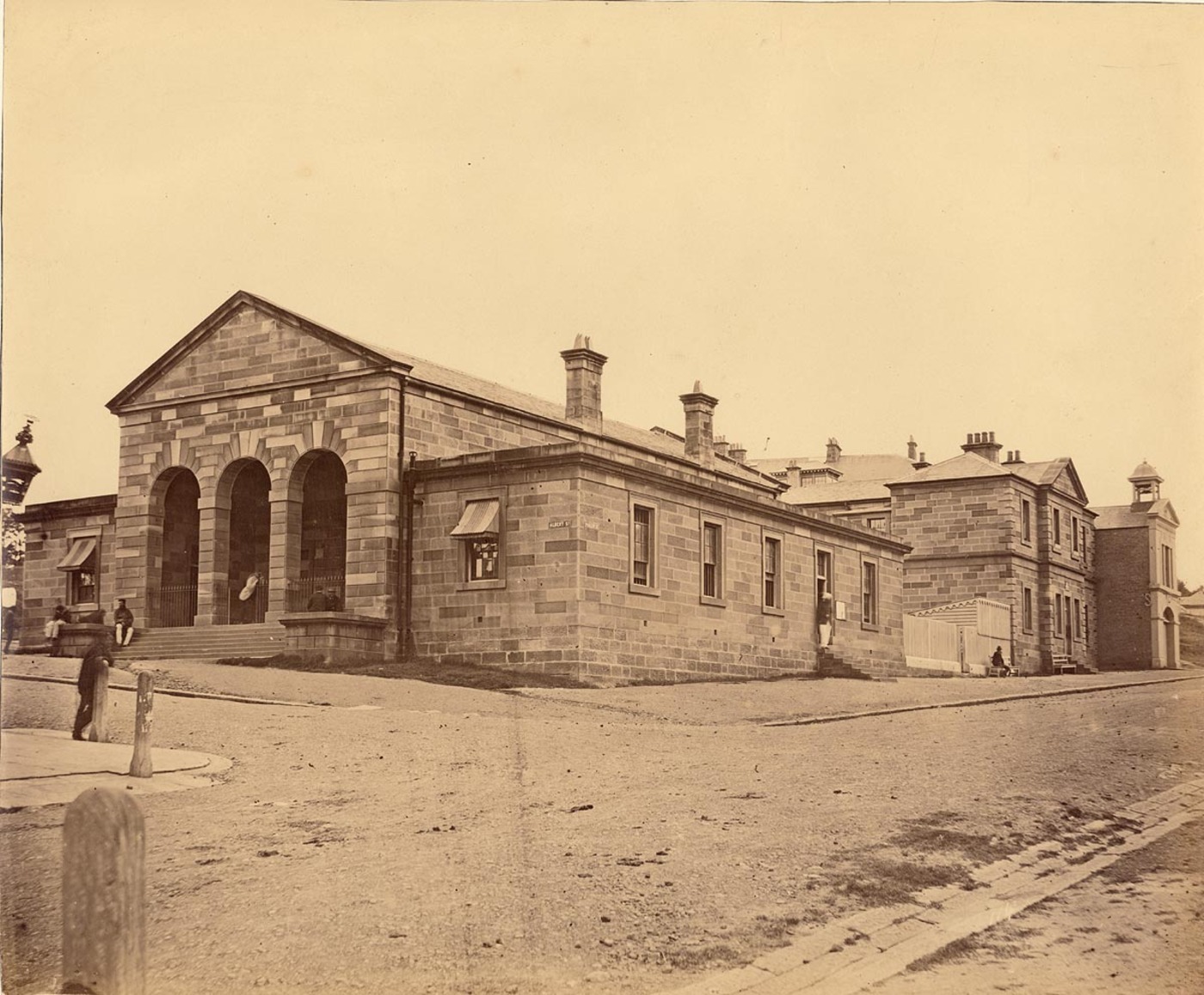
Water Police Court, Phillip Street, Sydney, 1870 [attributed to Charles Pickering] Image No: a1107019, courtesy State Library of NSW
In 1852, due to an influx of people with gold fever and a jump in crime, Water Police Stations were opened at Goat Island and Watsons Bay. Watson's Bay was considered an ideal as many sailing ships sheltered here and convicts could not easily stowaway on departing vessels with an able force on the lookout for them. In 1865 the Water Police moved to Campbells Cove at Dawes Point where they were until 1986.
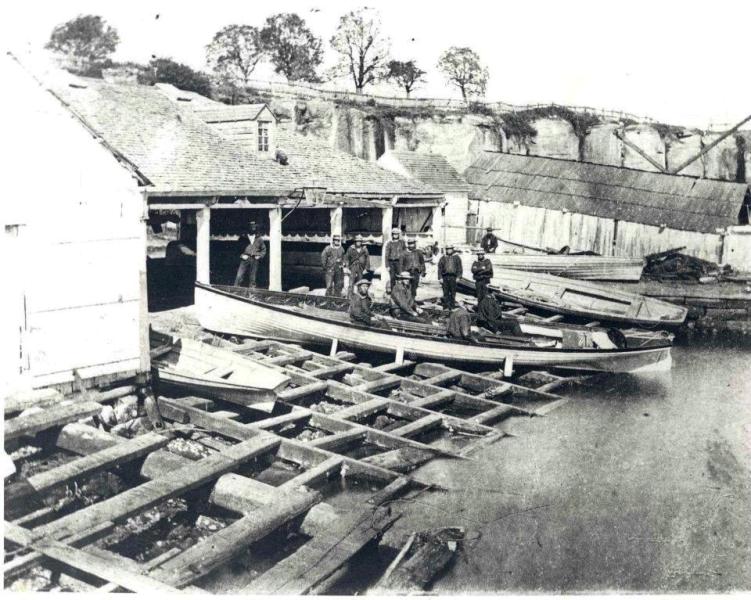
Water Police at Dawes Point c1870, courtesy Marine Area Command - NSW Police Force
Prior to the steam engine age Water Police needed in Pitwtater or Broken Bay would have use of revenue cutters, use whaleboats or hire smaller sailing ships to suit their needs:
In the 1880’s steam and combustion engines enabled the Water Police to be equipped with two steam launches, the ‘Biloela’ and the 'Nemesis' and later, the ‘Argus’, the fastest vessels on Sydney Harbour. These craft were in use for almost 35 years, when they were replaced by motor launches. A growing contingent of people taking to the harbour for regattas and to the waterways in Pittwater and Broken Bay necessitated a third launch - the Nemesis:
WATER POLICE REPORT.
Up to a late hour last evening the steam launch Nemesis of the Water Police was employed conveying to land those who were weather-bound in various parts of the harbour. The steamer was out at mid-night searching along the foreshores for any castaways who were compelled to land or had been driven ashore in the blow. WATER POLICE REPORT. (1896, September 14). The Sydney Morning Herald (NSW : 1842 - 1954), p. 5. Retrieved from http://nla.gov.au/nla.news-article14066451
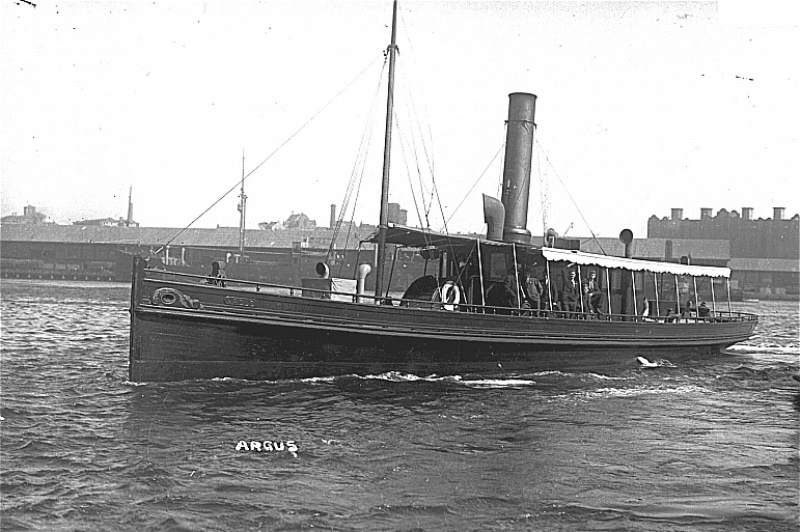
The Argus
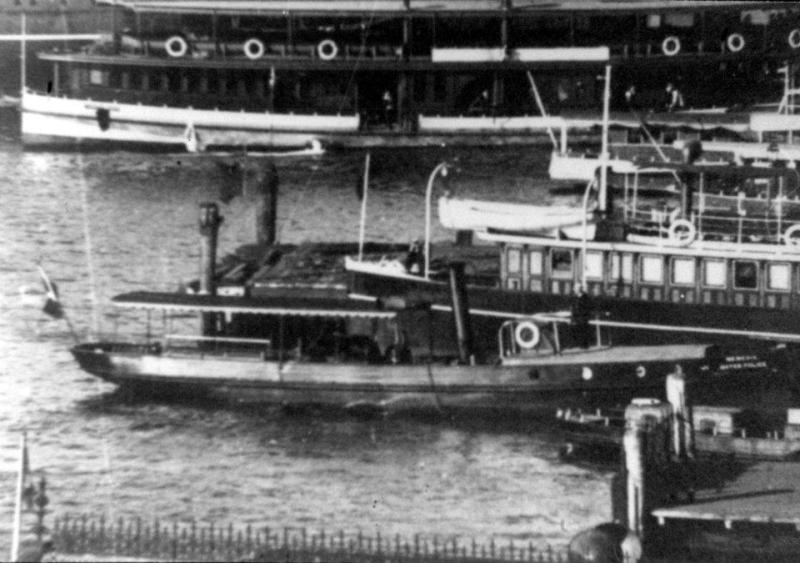
The Nemesis
After the Broken Bay Customs Station was closed in 1900 much of the search and rescue activities fell to local fishermen, lighthouse keepers (until automation of light in 1932) and the Royal Volunteer Coastal Patrol (founded 1937). Water Police vessels were sent out from Sydney Harbour as and when reports of lives in peril came in. The best history of our own division of these savers of lives while putting themselves in peril must come from those who have been or are Water Policemen;
History Of Broken Bay Water Police
Courtesy Brian Friend OAM
The Water Police section had its birth on Pittwater as a result of the prevalent stealing from private vessels in the area, however, while the prevention of theft is a part of our duties, Search and Rescue is our prime objective. The following resume of our work since 1966 may give you an indication of the workload and problems encountered by the men stationed here.
HISTORY
Prior to 1966 members of the Sydney Water Police transported 14' dinghies, powered by 35hp outboards, to the area on trailers and patrolled the area on nightshift in an attempt to curb the thefts from private boats. On 21 January 1966 the Police Launch 'Wallis', after having repairs carried out in Sydney, was attached to Mona Vale Police Station. The Launch was a 22' clinker timber half cabin, powered by a Ford Eaton V8 petrol engine. It was moored at Blacklers Boatshed near the public wharf at Church Point and was crewed by Senior .jpg?timestamp=1365865710062) Constable W. Kerr and Constables R. Beech, P. Sheehan and J. Gibbons. Accommodation at the boatshed at the time was in the form of a small office which was shared with the Volunteer Coastal Patrol and was supplied free of charge to the Department.
Constable W. Kerr and Constables R. Beech, P. Sheehan and J. Gibbons. Accommodation at the boatshed at the time was in the form of a small office which was shared with the Volunteer Coastal Patrol and was supplied free of charge to the Department.
On 17 September 1966 the vessel was renamed 'Vanguard' and remained in service until 17 February 1969 when due to a lack of security she was replaced with a larger vessel with a lock up cabin. The replacement vessel was 'Valiant' a 26' clinker Launch powered by a Crusade –Palmer V8 engine. At the same as the vessels changed so did the leadership, due to ill health Senior Constable Kerr retired medically unfit and he was replaced by Sgt 3/c R.L.S. Brown. The 'Valiant' served faithfully until she was replaced on 20 August 1971 by Launch 'Falcon' a 32' timber craft powered by twin 325hp Mercruised engines. About this time the strength was increased to six units. The crew was now;- Sgt 3/c Brown, Con 1/c McNamara, Con 1/c Gibbons, Con 1/c Dunbar, Con 1/c Wellings and Const Friend. At the same time the area patrolled was extended to cover an area from Bird Is. (just north of Norah Head) south to Long Reef and fifty miles to sea. Shortly after the arrival of 'Falcon' Blacklers Boatshed was pulled down and the Manager of Mitchells Boatshed, Mr David Arblaster, invited the Department to use office space in their Boatshed (Free of charge).
On 9 June 1974 three members of the crew;- Sgt 3/c 'Buster' Brown, Sen Con 'Boot' Wellings and Con 1/c 'Friendly' Friend risked their lives to rescue five people from a stricken yacht, 'Votan', which was caught in a bombora off Terrigal, as a result of this daring rescue the three were awarded the Queens Commendation for Bravery. From 1966 until June 1978 the crew were performing their duties in a part time capacity, performing General Duties on weekdays and Water Police duties mainly on weekends.
Left: Sir Roden Cutler presenting Friendly with aQueen's Commendation for Bravery.
In addition General Duties Police from Mona Vale Police Station were trained in deck duties. This practice was continued until the 11th of June 1978 when the police launch ‘Valiant’ was commissioned. This vessel is a 45’ Clinker steel launch powered by twin Cummins Diesel 6 cylinder engines each producing 540h.p.
The vessel is fitted with Koden Radar, a Furuno Depth sounder, a Cestral compass Noil Radio Direction Finder, Kestral Small Ships Radio, Weston 27meg radio and two Police Radios. With the replacement of the 'Falcon' with the 'Valiant' the crew was working full time Water Police Duties for the first time.
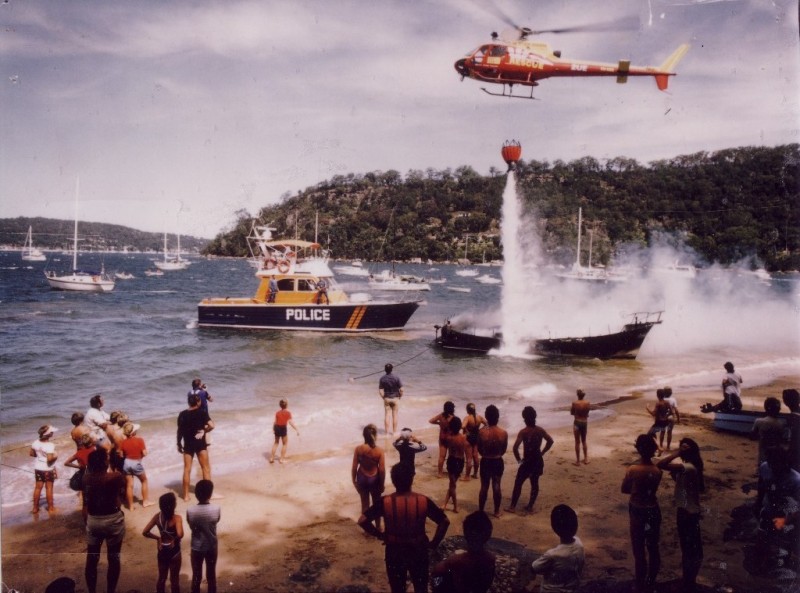
On the 25th of May 1979 our section was boosted by the addition of an F 100 utility for the use of carrying found dinghies and other property to the holding yard at Mona Vale and also for towing the Police Launch Mona Vale, a 21' aluminium runabout powered by twin 70hp Johnson's which arrived on 10 September 1979.
On the 30th of March 1980 the Station was made an official Water Police Station and the strength was increased to 11 with an extra unit to be made available in the near future. These crew members are:- Sgt 2/c Merv Bush, Sgt 3/c John McNamara, Sen Con Brian Friend, Sen Con Alan Anderson, Con 1/c Graham Botham, Con 1/c Lindsay Dive, Con 1/c Ian Iszlaub, Con 1/c Gary Figgis Con 1/c Dave Kingsley, Con 1/c Jim Williams and Const John Cuthbert with Const Glen Finnis to be transferred here shortly.
Statistics of Rescues.
66-69 Rescue statistics not kept. Rescues Property
Boats Males Females Outside Value p.a.
1969 63 102 36
1970 95 200 67
1971 141 267 123
1972 148 240 101
1973 89 80 81
1974 192 ---419---
1975 167 ---353---
1976 168 ---416---
1977 238 ---136--- 85 $2,749,000.00
'1978 196 ---594--- 33 $3,700,000.00
1979 221 ---748--- 40 $5,856,000.00
General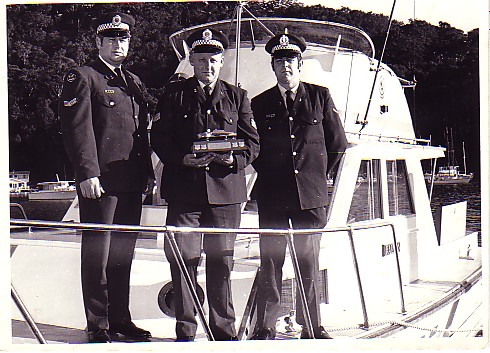 In the years since 1966 the Water Police have had a good association with the R.V.C.P. and the V.C.G. on an official and a social level. We regularly compete in declared speed events to Wisemans Ferry and the Clae engine trophy, having won both events at different times. We also have an association with the various private radio bases situate in the area.
In the years since 1966 the Water Police have had a good association with the R.V.C.P. and the V.C.G. on an official and a social level. We regularly compete in declared speed events to Wisemans Ferry and the Clae engine trophy, having won both events at different times. We also have an association with the various private radio bases situate in the area.
The men attached to the Water Police undergo various training courses in boat handling, navigation, use of radios and Radar equipment and in addition all Police must obtain their Coxswain and Drivers Certificates by undergoing an N. S.B . examination.
It is also the duties of the Broken Bay Water Police to convey injured persons from the Western Shores and Scotland Island to the mainlabnd, to fight fires in these areas and to convey good and bad news to the people who live there. It can be seen from the statistics and facts herein that the men attached to this station provide an invaluable service to the Boating public in the Pittwater- Broken Bay area.
Marine Area Command
NSW has a large and busy coastline leading to an expansive system of waterways. The NSW Police Marine Area Command's (MAC) responsibility extends to all coastal area's of NSW to 200 Nautical Miles out to sea. From the earliest days of settlement, the state has required a dedicated water based policing service. The services provided by MAC are similar to those carried out by land-based police, including crime prevention and detection,search and rescue.
With the introduction of the NSW Police Marine Area Command in July 1999, equipment includes 11 sea going craft and a number of smaller boats, all with electronic navigational aids. MAC employs 123 personnel, including operational water police, marine intelligence unit, marine crime prevention officer, divers, detectives and the marine operational support team (MOST). With an increasing amount of commercial shipping and the immense expansion in the number and type of leisure craft on our waterways, the Water Police are being called on more and more to drive down marine crime.
Their duties include:
- policing the waterways of NSW to reduce marine crime
- protecting life and property, both at sea and on inland waters
- overseeing aquatic events and controlling spectator craft
- coordinating search and rescue off the coast of NSW
- carrying out diving operations and underwater searches for missing persons and evidence
- maintain and service police launches
- addressing marine crime prevention issues
- safety and compliance reinforcement
Mission Statement
To be the premier Marine Law Enforcement Command in Australasia and to provide professional service to the community to reduce marine crime and maintain search and rescue effectiveness.
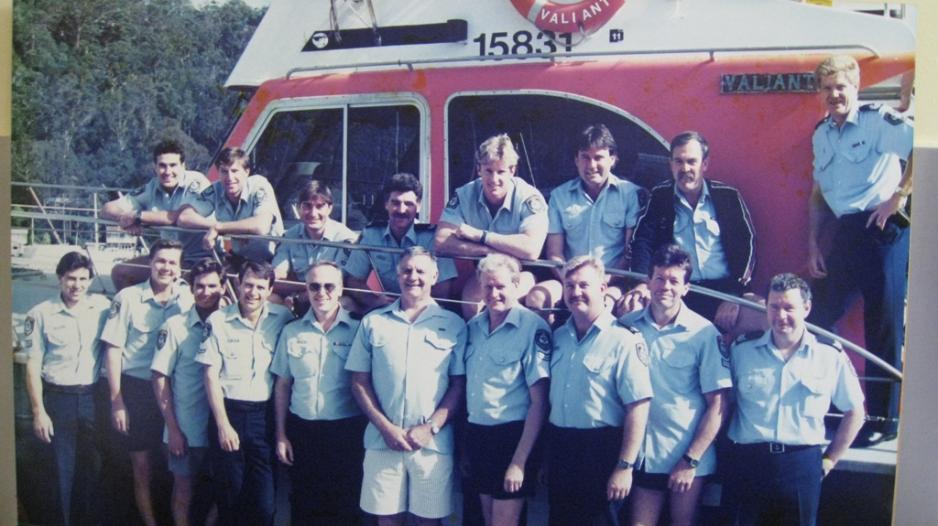
John Dunbar Farewell on the Valiant - Broken Bay Water Police.
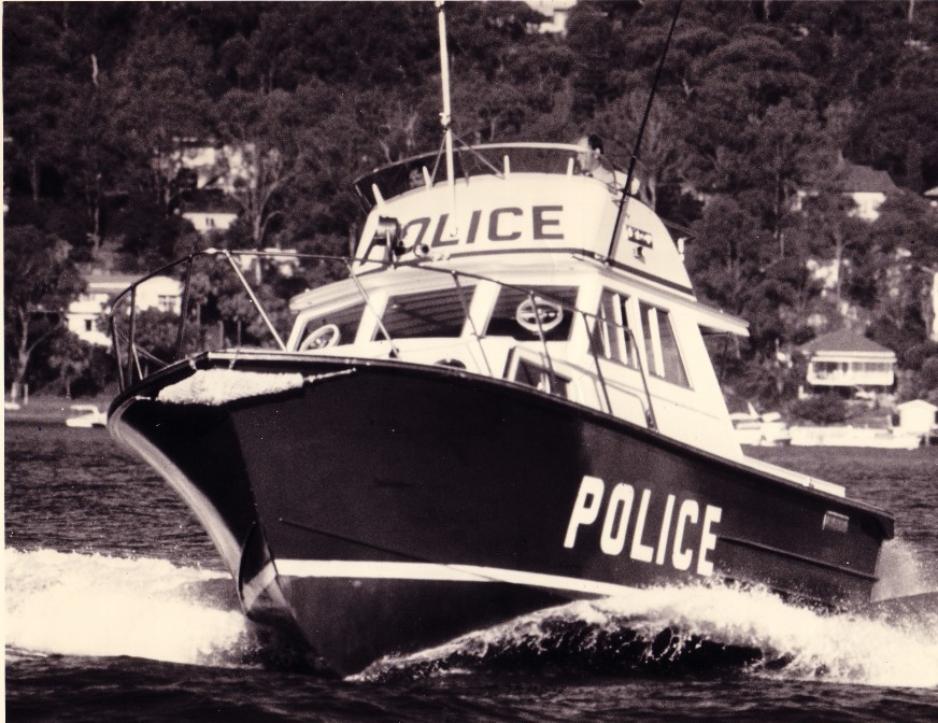
The Falcon at Broken Bay Water Police.
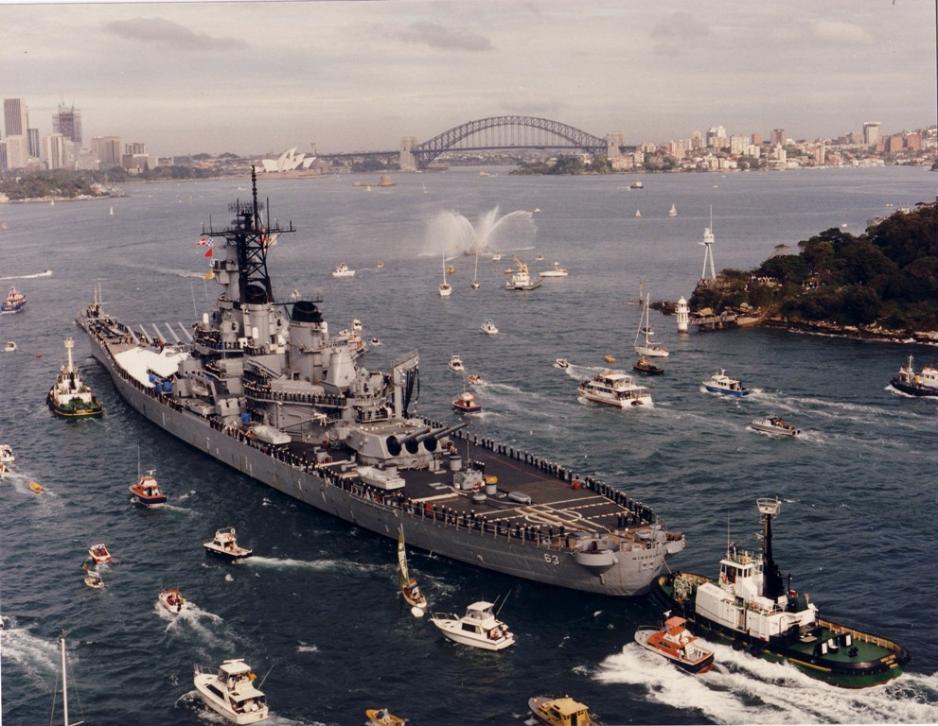
USS Missouri - 1986 - when large events are occurring on our waterways the Water Police are on duty and rostered into these areas from all divisions - the Olympic Games or visitng V.I.P.'s are all escorted during water visits, by the Water Police.
Broken Bay Water Police History and Photographs courtesy of Brian Friend (Friendly) extra threads by A J Guesdon, 2013.
Broken Bay Water Police By David Buchanan
A Great Slideshow of our very own Broken Bay Water Police by one of these gentlemen. The BBWP have served Pittwater and the greater Broken Bay area since 1966